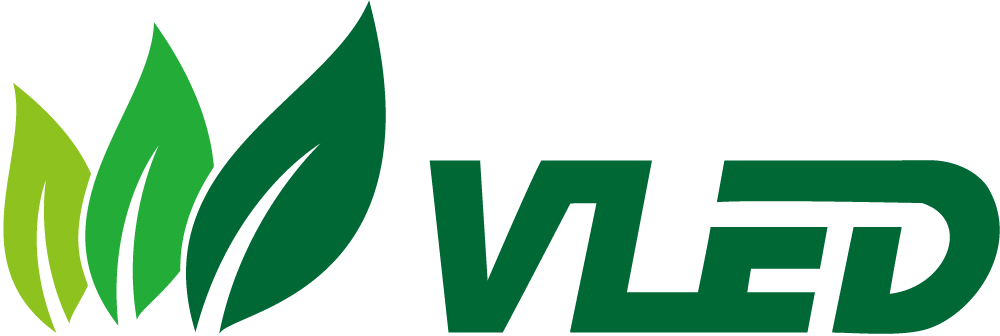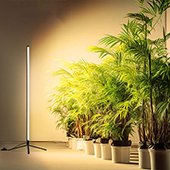Menu
Do You Need Grow Lights for Hydroponics?
Nowadays, indoor hydroponic cultivation is becoming increasingly popular, whether it’s in cramped city apartments or modern agricultural greenhouses. Hydroponic cultivation is like a magical little spell that allows us to cultivate lush greenery in limited spaces.
Why is it so popular?
There are two main highlights: Firstly, the ultra-high space utilization rate. You no longer need vast tracts of land to create a green oasis; secondly, soilless cultivation reduces the hassle associated with soil, such as dealing with pests and diseases. Cleaning up is much easier compared to traditional soil-based planting.
However, the focal point we need to discuss is this: When you decide to engage in hydroponic cultivation at home or in commercial facilities, is it necessary to have a grow light?
We’ve all heard that light is vital to plant growth, but with hydroponics as a specific type of growing, does light need to change? And how much of a role can grow lights play in this? Follow along as we explore down the road!
Limitations of Natural Light in Hydroponic Environments
In home or greenhouse hydroponic cultivation, natural sunlight availability can be significantly influenced by seasons and geographic location.
For example, in Beijing, China, during winter, sunlight hours are noticeably reduced, and the intensity of sunlight is weaker. This reduction in sunlight exposure can limit the growth of hydroponic plants, as they receive less energy for photosynthesis. Consequently, plants may exhibit stunted growth and yellowing leaves, indicating a lack of sufficient sunlight.
In contrast, during summer, sunlight can be intense, especially around midday. Direct sunlight can raise the temperature of the water reservoir in hydroponic systems, potentially causing discomfort to the plants. This heat stress can lead to leaf burn and restricted growth, particularly if hydroponic setups are placed near windows where sunlight exposure is intense.
Overall, the variability in natural sunlight availability presents challenges for hydroponic growers, affecting plant growth and health. To mitigate these limitations, growers often supplement natural sunlight with artificial grow lights to provide consistent and optimal lighting conditions for their hydroponic plants throughout the year.
Additionally, the positioning within the home is crucial for hydroponic cultivation. Locations closer to windows generally receive better sunlight exposure compared to areas in the middle of the house, especially those facing south, which receive relatively ample sunlight throughout the year.
However, even in these favorable locations, indoor elements such as glass, curtains, and furniture can partially block and filter sunlight, reducing the actual light reaching hydroponic plants and turning it into diffused softer light.
While greenhouse environments allow for temperature and humidity control, they are still subject to seasonal and geographic influences. Particularly in regions farther from the equator, issues such as shorter daylight hours and lower sunlight intensity become more prominent during winter.
Without supplemental lighting, hydroponic plants may experience slow growth, sparse foliage, and dull coloration, similar to how calcium-deficient children have weak bones. Insufficient light can hinder normal growth and development in plants.
Dear gardeners, when taking care of hydroponic plants, remember to observe the natural light conditions in your home, adjust their positioning accordingly, and use artificial lighting when necessary to supplement sunlight. This is essential to maintain their healthy green vitality!
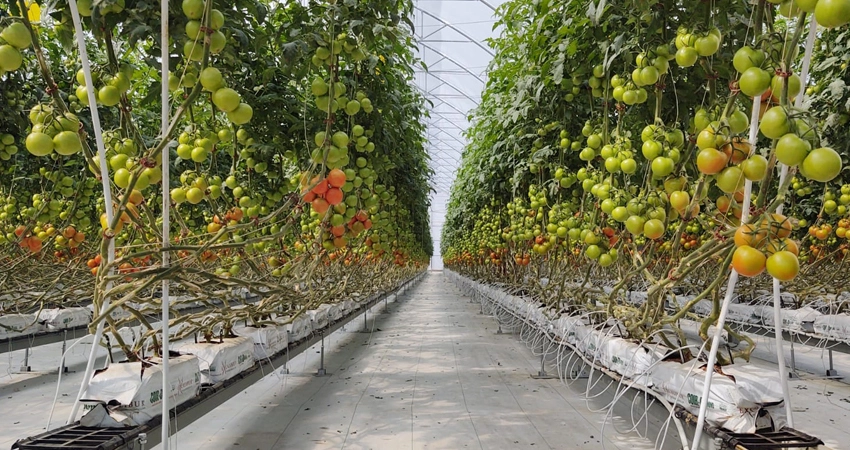
Supplementary Light/Hydroponic Tomato Yields Increased by 31.63%
The reason grow lights are so powerful is that they can simulate sunlight, acting as faithful replicas of sunlight. It’s important to note that sunlight contains various colors of light, and each color of light has a unique effect on plant growth.
Next, let’s take a look at how grow lights work their magic in hydroponic greenhouses.
The Beijing Polaris Agricultural Industrial Park is located in Miyun District, Beijing (40.4°N, 117°E). The climate in Miyun District is characterized by a warm temperate monsoon-influenced continental climate, with semi-humid and semi-arid conditions. Sunlight exposure is significantly higher in the summer and autumn seasons compared to winter and spring.
For example, in 2021, the total accumulated sunlight reached 492,177 J/cm2 throughout the year, with sunlight in the summer and autumn seasons being 1.67 times higher than in the winter and spring seasons.
However, since the greenhouse is used for planting winter tomatoes, with planting in September and harvesting in June, even though sunlight intensity and quality are higher during the summer season, it cannot directly translate into higher yields.
Therefore, the primary goal is to improve sunlight exposure in the greenhouse during the summer and autumn seasons to increase yields.
Many factors influence the available light intensity for plants inside the greenhouse:
- To increase light exposure, the greenhouse in the park uses diffuse glass, which has high light transmittance and ensures uniform distribution of light. This helps reduce shading of lower leaves by upper leaves, and minimizes the formation of shadows after sunlight exposure, promoting balanced crop growth.
- Regular use of fully automatic roof cleaning machines to clean the roof, which can increase light transmittance by up to 10% after cleaning.
- Equipped with 1000 W high-pressure sodium lamps, with 18 lamps in each row, spanning 5 rows, totaling 28 spans and a total of 2520 lamps. The photosynthetic photon flux (PPF) output is 2100 μmol/s, with the lamps positioned approximately 3 meters above the plant canopy.
However, despite efforts to maintain optimal light transmission, various factors can still lead to reduced transmittance in the greenhouse. Factors such as the aging of equipment, glass, and covering materials, as well as the presence of hardware structures like trusses and shading curtains, can contribute to partial shading in certain areas.
Each supplemental lighting fixture covers an area of 0.1058 square meters, while the shading area of a single truss and retracted curtain is 25.76 square meters. Excluding the overlapping areas between supplemental lighting fixtures and trusses, the total shading area can reach 811.44 square meters.
The greenhouse in the park was constructed in 2016. To conduct transmittance tests, 10 random test points were selected inside the greenhouse in December 2021 at 12:00. The average transmittance was measured at 86.64%, which is lower than the original value recorded when the greenhouse was first constructed.
Experimental Materials and Methods
In response to lower-than-expected yields during the winter and early spring planting seasons of 2020-2021 due to reduced sunlight, during the 2021-2022 planting season, Polar Agriculture considered the cost and the nighttime temperature requirements of the plants.
From November 2021 to March 2022 (spanning from week 45 of 2021 to week 13 of 2022, totaling 22 weeks), supplemental lighting with high-pressure sodium lamps was used from 23:00 to 7:00 the following day.
Meanwhile, irrigation frequency at night was increased to meet the growth requirements of the plants. The duration of supplemental lighting in November and March was adjusted relative to the decrease/increase in daylight hours.
The experiment was conducted in the contiguous glass greenhouse of Polar Agriculture Co., Ltd. The greenhouse has an area of 3.3 hectares, oriented in a north-south direction with 28 spans in the east-west direction.
Each span has a width of 8 meters and contains 6 cultivation racks. The cultivation troughs are 80 meters long with row spacing of 1.6 meters. The experiment utilized an introduced cocktail tomato variety.
During the tomato growth process, the nutrient solution is delivered through drip irrigation using an automatic fertigation system integrated with the irrigation system. The irrigation timing and frequency are automatically adjusted based on the sunrise and sunset times and the cumulative daily light exposure.
The cumulative external light exposure data outside the greenhouse is monitored and uploaded by the Priva weather station, while the photosynthetically active radiation (PAR) data inside the greenhouse is captured and recorded by light sensors.
Various growth parameters of the plants, such as weekly stem elongation, weekly number of fruiting trusses, and fruits per truss, are recorded by technicians every week. Yield is recorded daily and aggregated statistics are compiled over the weekends.
Analysis of Results
Overall, the cumulative outdoor light exposure did not vary significantly between the two growing seasons, with relatively average cumulative light exposure during the winter season.
Light exposure showed an increasing trend with the seasons, particularly noticeable in February to March 2022. The overall trend of indoor photosynthetically active radiation (PAR) followed a similar pattern to the cumulative outdoor light exposure over time.
However, after the introduction of supplementary lighting, the intensity of PAR available to the plants indoors during the 2021-2022 growing season increased to 1.24-1.75 times that of the 2020-2021 growing season.

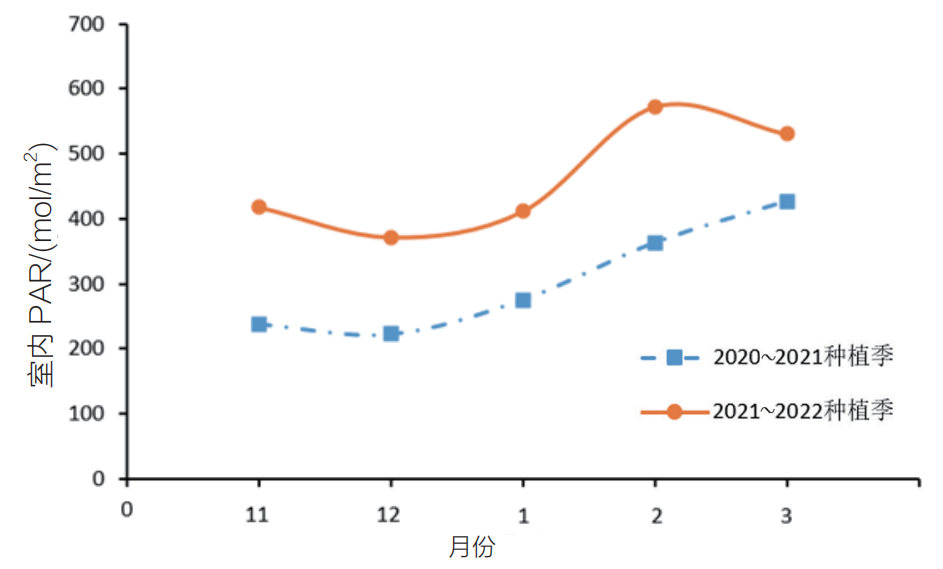
Plants require light for growth, and generally, stronger light intensity promotes better plant growth within a certain range. Due to the supplementary lighting provided during the 2021-2022 growing season, tomato plants may exhibit improved physiological development compared to the previous season.
Based on the weekly crop records, the growth rate of the plants during the 2021-2022 growing season equals or exceeds that of the 2020-2021 growing season, indicating relatively better growth performance.
Additionally, through comparison, it was observed that the overall trends of the two growing seasons were similar. In the fifth week of the 2021-2022 growing season, there was a sharp increase in stem elongation, but in the sixth week, there was a sudden decrease.
This might be due to the Chinese New Year falling in the fifth week of 2022, resulting in delayed measurements and the accumulation of growth data. Therefore, human intervention is also an indispensable factor in production.
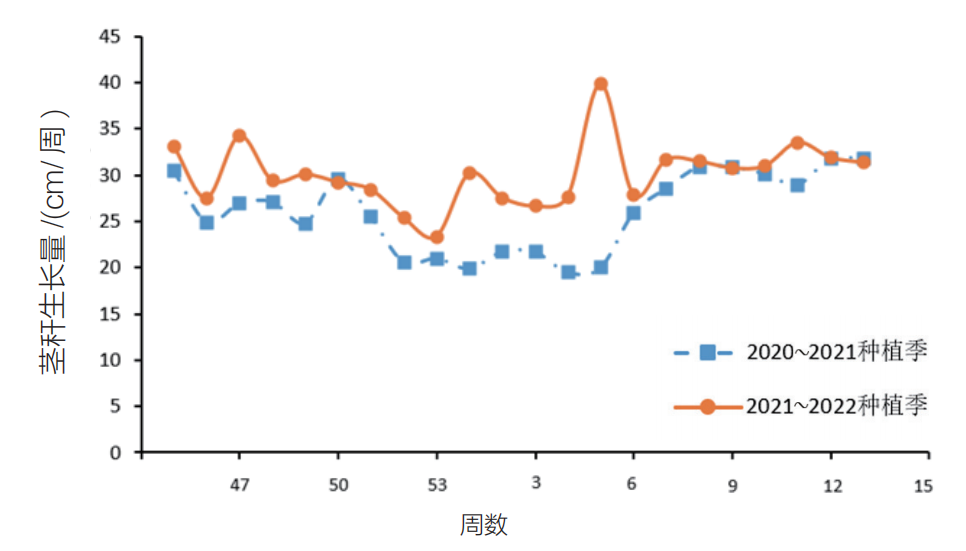
The number of fruit clusters and fruits per week can reflect the reproductive growth capacity of crops. At the beginning of November, the number of fruits per plant was the same for both growing seasons.
However, as the growing season progressed, the gap between the number of fruits per plant with supplemental lighting and those without gradually widened.
At the end of the supplemental lighting period, the plants in the 2021-2022 growing season had produced 27.5 clusters of fruits, while those in the 2020-2021 growing season without supplemental lighting ended with 26 clusters of fruits, resulting in a difference of 1.5 clusters of fruits.
Although the number of fruits per week fluctuated, overall, the 2021-2022 growing season had a higher weekly fruit yield compared to the 2020-2021 growing season, with a significant difference.
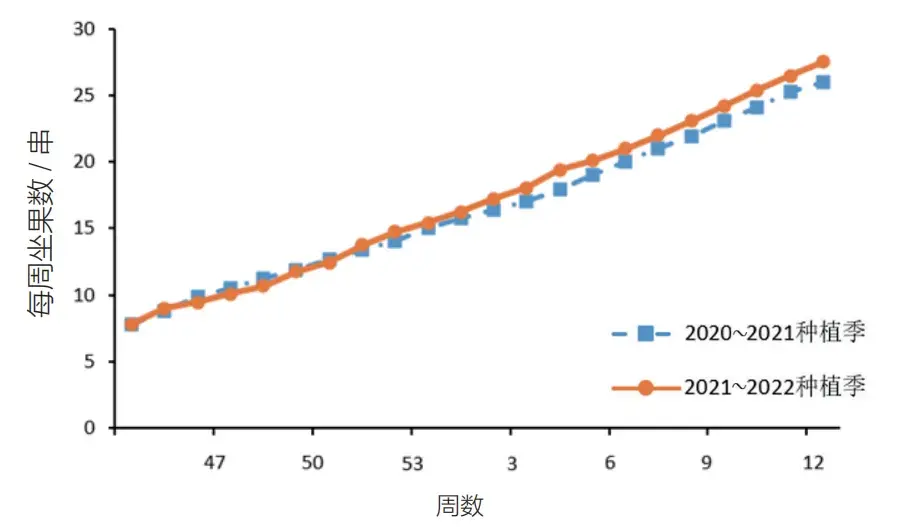

In the Netherlands, among growers and researchers, there is a belief that for every 1% increase in light intensity, there is a corresponding 1% increase in yield. This is attributed to crops being able to enhance photosynthesis by absorbing more light, ultimately leading to increased yield.
In both planting seasons, the plant density was maintained at 3.75 plants per square meter. However, the yield after supplemental lighting was significantly higher than without supplemental lighting, with an average increase in yield of 31.63%. The largest difference was observed in January.
During the 2021-2022 planting season, the monthly yield was 1.44 times higher than that of the 2020-2021 planting season. This increase in yield could be attributed to the rise in temperature resulting from the additional supplemental lighting, which accelerated the ripening and coloration rate of the fruits.
Furthermore, the tomato yield exhibited a trend of initially increasing, then decreasing and then increasing again. This trend was contrary to the variation in light intensity inside the greenhouse, which initially decreased, then increased, and then decreased again.
This observation suggests that there is a lag of about one month between the perception of environmental changes by the lower and upper parts of the tomato plants.
Conclusion
Based on the obtained crop indicators, it can be concluded that the addition of supplemental lighting is more beneficial for crop growth. The supplemental lighting, coupled with the increase in temperature, accelerates fruit setting and ripening, enhances maturity speed, and consequently leads to higher yields.
Additionally, concerning the supplemental lighting strategy, particularly the morning light-off strategy, to prevent light fluctuations and align with the natural growth rhythm of plants, the number of supplemental lights gradually decreases with sunrise.
After sunrise in the morning, at around 7:30, half of the supplemental lights are turned off. When the external light intensity reaches 300 W/m2, all supplemental lights are switched off.
The decision to provide supplemental lighting during the night also takes into consideration energy consumption and peak/off-peak electricity prices.
In the suburbs of Beijing, the nighttime electricity price is 0.3 yuan/(kW.h), while the peak and off-peak prices are 0.89 and 0.59 yuan/(kW.h) respectively. Providing supplemental lighting during the night saves nearly half of the costs.
Get in touch with us!
From custom light planning, to tailored quotes, and everything in between, our team of horticulture experts are always ready to assist.
